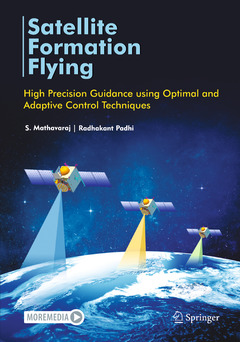Description
Satellite Formation Flying, 1st ed. 2021
High Precision Guidance using Optimal and Adaptive Control Techniques
Authors: Mathavaraj S., Padhi Radhakant
Language: English
Subjects for Satellite Formation Flying:
168.79 €
In Print (Delivery period: 15 days).
Add to cartPublication date: 03-2022
154 p. · 17.8x25.4 cm · Paperback
168.79 €
In Print (Delivery period: 15 days).
Add to cartPublication date: 03-2021
154 p. · 17.8x25.4 cm · Hardback
Description
/li>Contents
/li>Biography
/li>Comment
/li>
Dr. Mathavaraj S is a space scientist working at the Indian Space Research Organization (ISRO). He earned his Bachelor of Engineering in Aeronautical Engineering from Hindustan College of Engineering, Padur, followed by Master of Technology in Aerospace Engineering from Indian Institute of Technology, Madras and Ph.D. in Aerospace Engineering from Indian Institute of Science, Bengaluru. His interest in space dynamics made him pursue his career in Flight Dynamics Group at U. R. Rao Satellite Center (URSC) of ISRO. His contributions at ISRO include maneuver strategy design for geostationary orbit and lunar capture orbits, attitude profile generation during engine firing and constrained trajectory optimization for soft lunar landing. He is also passionate about formation flying of satellites. For his contribution in the space field, he received ISRO's Young Scientist award in 2018.
Dr. Radhakant Padhi is currently working as a Professor in the Department of Aerospace Engineering and also in the Center for Cyber Physical Systems, Indian Institute of Science (IISc), Bangalore. He earned his Masters and Ph.D. in Aerospace Engineering from IISc Bangalore and Missouri University of Science and Technology, USA respectively. Dr. Padhi is a Fellow of Indian National Academy of Engineers, a Fellow of Institution of Engineers (India) and a Fellow of Institution of Electronics and Telecommunication Engineers. He is an Associate Fellow of American Institute of Aeronautics and Astronautics (AIAA), a Senior Member of Institute of Electrical and Electronics Engineers (IEEE). He is a Vice Chair of the Publication Board of the International Federation of Automatic Control (IFAC) and has been a member of its Council during 2014-2020. He is a life member of Aeronautical Society of India, Systems Society of India and Soft Computing Research Society. Dr. Padhi's research interest l
Covers optimal as well as adaptive control strategy for high precision formation flying of small satellites
Presents detailed formulation along with merits and demerits of all the discussed approaches
Includes program files in MATLAB for all the discussed approaches




